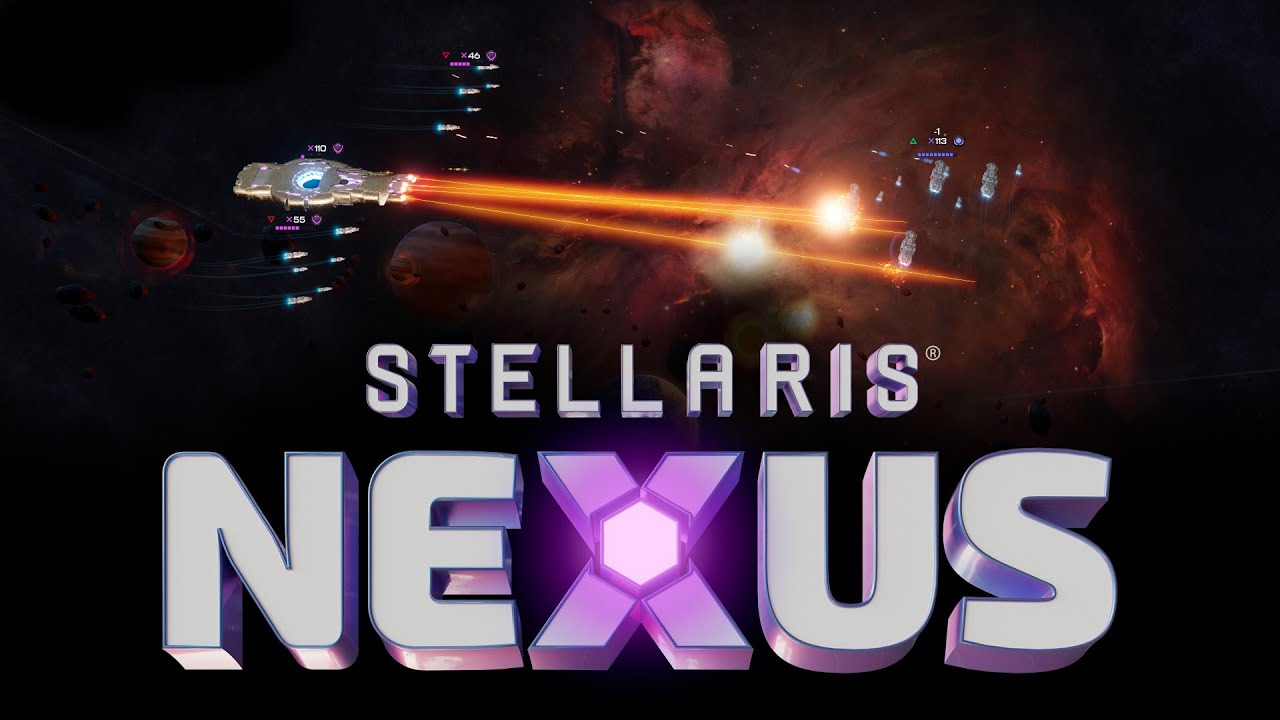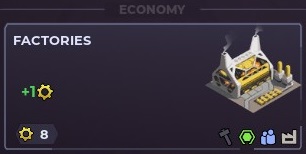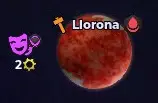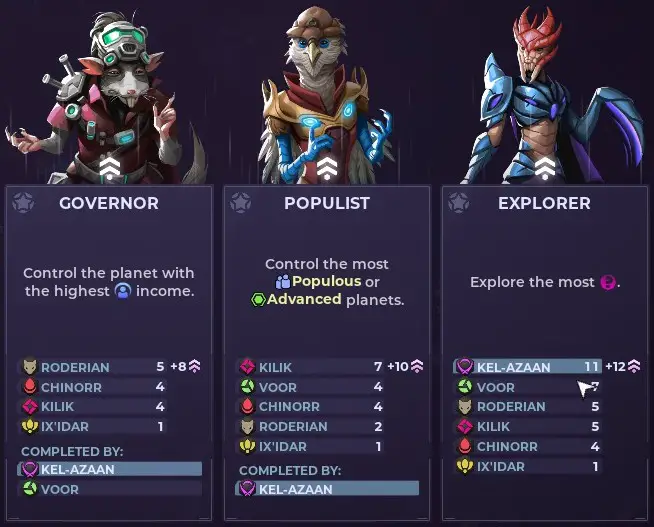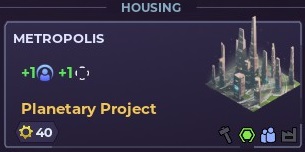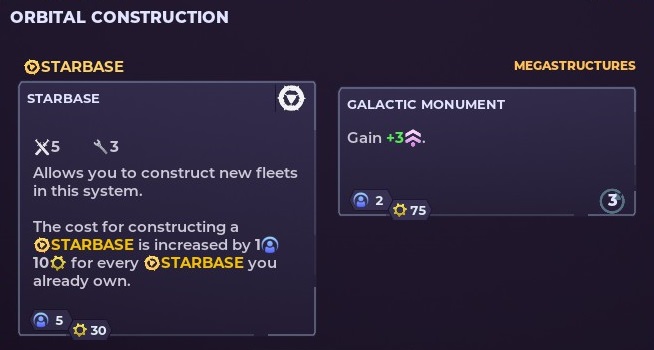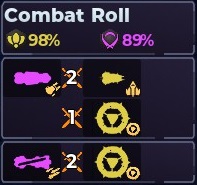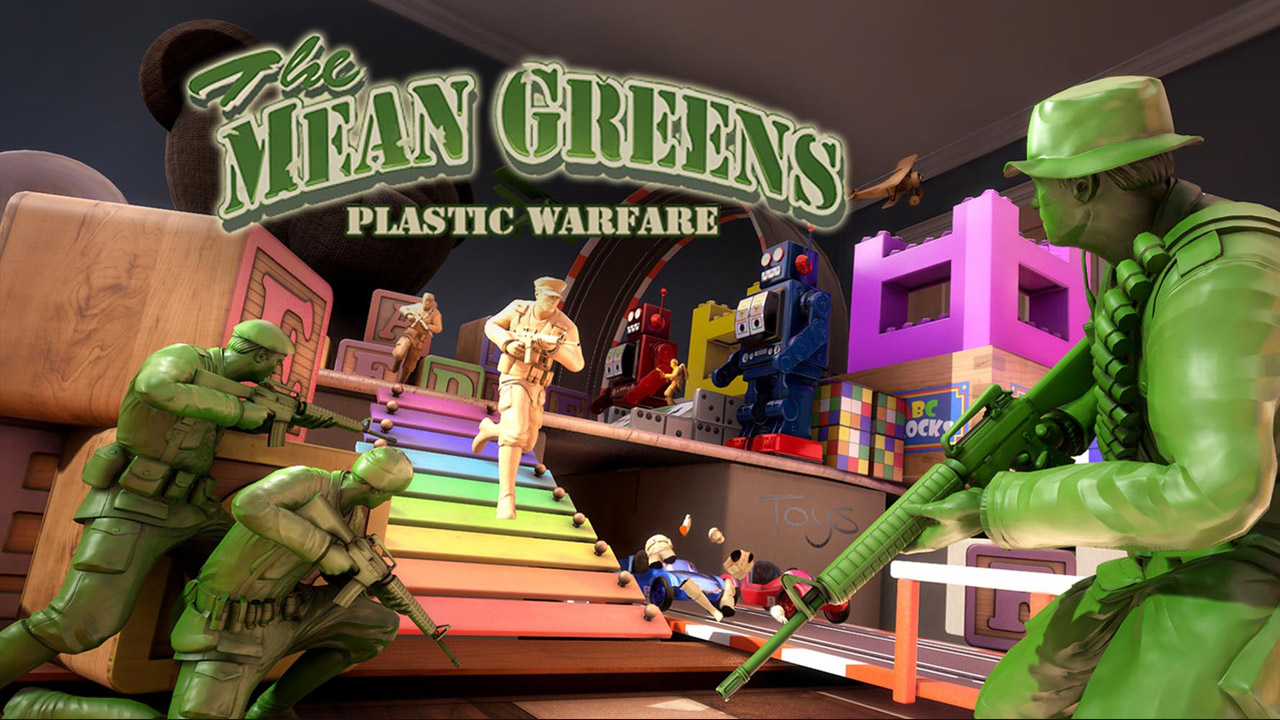An introduction to SN’s gameplay mechanics, such as resources, planets, fleets and edicts
RESOURCES
Resources in SN can be presented in two different ways.
Stockpile + income is how support, materials and succession points are expressed:
- Stockpile is the amount of resources currently available to spend.
- Income is the amount of extra resources generated at the end of the turn and turned to stockpile for your next turn.
Mobilized / cap is how science and munitions are expressed:
- Mobilized is the current amount of resources already in use.
- Cap is the current maximum value which can be used.
Support
Support is the key resource of SN. It allows you to take actions such as moving fleets, passing edicts and building starbases. Support management is key to keeping a good flow of productive actions.
Your faction and leader generate some support, but the bulk of your empire’s support will come from planet projects.
Each turn, your 1st action costs 1 support. Additional actions cost increasingly high amounts of support.
– The 2nd action costs 2 supports (for a total of 3)
– The 3rd action costs 3 supports (for a total of 6)
– The 4th action costs 4 supports (for a total of 10)
– The 5th action costs 5 support (for a total of 15)
And so on.
Multiple actions, such as edicts, have an additional support cost.
Each controlled planet passively reduces by 1 your support income. Consider it before taking over planets lacking a native support income.
Materials
Materials are the resource required to build planet projects and orbital items. They can also be used to research techs from the physics and nanotech trees.
You will get most of your materials from economy projects. Invading planets will grant a small amount of looted materials.
Credits
You can use credits as a replacement currency when you’re out of stockpile support or materials. 2 credits are worth 1 support, and 1 credit is worth 1 material.
Credits are mostly gained by trading with other empires and neutral planets.
Munitions
Munitions, also known as ammo, are required to increase your number of fleets and ships. If you overtake your cap of munitions, your number of ships will gradually decrease until your amount of mobilized munitions returns to a value inferior or equal to your cap.
To increase your cap of munitions, build military projects and research specific techs.
Science
Science is required to research or acquire new technologies. If you lack science, you won’t be able to get anything from the Research edict.
To increase your science cap, build science projects.
Trade value
Increases your income of credits when trading with other empires and neutral planets. Generated by building projets.
Culture
This feature represents the presence of a foreign culture on a planet.
Each planet can have a single foreign culture present at a given time. Adding a new foreign culture replaces the existing foreign culture.
An empire controlling a planet with a foreign culture will suffer from a reduced support income.
Spreading culture to a neutral or rival planet grants multiple benefits to the empire with the same culture:
- It gains a resource income depending on the target planet’s type.
- Its plots on the target planet are resolved in 1 fewer turn.
- When conquering the target planet, the planet loses its foreign culture but doesn’t suffer from a turn in anarchy.
Army strength
Army strength rules combat between fleets and planets.
A fleet must sacrifice ships to take control of a planet. The compared army strength of the attacking and defending empires defines how many ships are sacrificed, and how many materials are gained from plundering the planet. See Fleet-to-planet combat below for more details.
Army strength can be increased by researching technologies and building military projects.
Council votes
In Succession mode, a council gathers every 8 years.
During the council phase, you can vote for a new title and a new resolution. The new title will be available to unlock for the rest of the game. The resolution will be applied to all empires until the next council.
Vote weight depends on controlled systems and culture. Votes casts from titles and resolutions which don’t win the current round will carry over to the next council.
Succession
In Succession mode, the leader of the first empire to reach 100 succession points (SP) becomes the emperor and wins the game.
There are five main ways to gain SP:
- Sign pacts with other empires
- Build mega structures in orbit of your planets
- Spread your empire’s culture on foreign planets
- Level up your leader
- Secure titles before the next council
Each title can be unlocked once per empire, with the notable exception of Regent which grants SP at every council. Here are some of the titles.
- Regent: control the planet Nexus
- Conqueror: control the largest number of systems
- Explorer: explore the most anomalities
- Far sighted: have a presence (?) in the highest number of systems on the edge of the map
- Governor: control the planet with the highest support income
- Industrialist: have the highest income of materials
- Learned: control the planet with the highest science output
- Opulent: have the highest stockpile of credits
- Populist: control the largest number of populous or advanced planets
- Producer: control the largest number of industrial planets
Being the first empire to score a given title grants 12 SP, but the more empires get it, the less SP other empires will gain from unlocking it. The penalty is 2 SP per empire already owning the title.
SYSTEMS and PLANETS
The map of a game is called the known space. Each node on the map is a system. Some systems have a planet, some don’t. The path between two adjacent systems is called a hyperlane and can be travelled by fleets.
Planets can be either neutral or controlled by an empire.
Systems can feature unexplored anomalies. Their content can be revealed with the Explore edict.
Planet types
The type of a planet determines which projects can be built on its surface.
There are four planet types, expressed by different icons:
- Rich planets (orange hammer icon) are specialised in materials-generating projects.
- Advanced planets (green hexagon icon) are flexible project-wise, but their building costs tend to be more expensive than specialised planets.
- Populous planets (blue people icon) have more building slots available than other planet types, and are specialised in support-generating projects.
- Industrial planets (grey factory icon) are specialised in projects able to turn materials into other resources such as ammo, science and trade value.
Planet projects
Planets have a number of available surface slots which can be used to build projects.
Extra slots can be opened by building housing projects.
Each planet can have a single Planetary Project.
Planet invasion
Taking over a neutral or enemy planet requires a fleet and no enemy fleet or starbase in the system. See Fleet-to-planet combat below for more details.
Immediately after its conquest, the planet falls into anarchy (red fist icon), unless it was under the cultural influence of the conquering empire. Anarchy prevents from building projects or orbital items until the next turn.
Orbital construction
Each planet in your control has access to orbital construction, unless the planet is in a state of anarchy or an enemy fleet is present in the system.
Orbital construction allows building the following items:
- A starbase. It costs increasing amounts of support and materials. A starbase helps defending the system from enemy fleets, and allows the local empire to build fleets.
- Fleets of ships. They cost munitions. The new fleet will appear at the start of the following turn.
- A galactic monument. It costs materials. After its completion, it provides 3 succession points to the empire controlling the planet.
FLEETS
A fleet is a group of identical ships able to travel to other systems, invade other planets and fight enemy fleets.
A fleet can move from a system to an adjacent system through a hyperlane connecting them. Moving a fleet on a hyperlane is called a jump.
There are three types of fleets:
- Raider fleets are the equivalent of cavalry. They’re fast (can move to systems 2 jumps away) and strong against ranged fleets.
- Capital fleets are the equivalent of spearmen. They’re strong against raiders.
- Ranged fleets are the equivalent of bowmen. They’re able to target fleets in adjacent systems and strong against capital fleets.
Fleets have two or three attributes:
- Strength determines the damage dealt in combat. Each ship in the fleet contribues to the fleet’s total strength.
- Ranged attack (ranged fleets only): determines the damage dealt when shooting a target in another system.
- Engineering determines the maxium number of ships which can join the fleet every turn as reinforcements.
Reinforcing an existing fleet can be done on any planet under your control, unless it’s in anarchy. The more support, munitions and turns are spent to reinforce it, the more extra ships will join the fleet.
Two fleets of the same type present in the same system can be merged as a single fleet.
Fleet-to-fleet combat
If present in the same system, two or more fleets or starbases from different empires at war will fight at the end of their turn.
A fight is broken down into rounds. At each round, each surviving fleet will deal damage to one hostile surviving fleet, until only fleets from a single faction are left.
Each fleet will attempt to target a fleet it has an advantage over. For instance a capital fleet will always attempt to attack a raider fleet to deal +50% damage. If there isn’t any target with advantage, then the fleet will attempt to target a fleet it has neither advantage nor disadvantage over. If this isn’t possible either, then the fleet will target a fleet with disadvantage, dealing -50% damage.
The screening fleet role nullifies this target preference… until the screening fleet is destroyed.
A fleet attacked by enemy fleets coming from more than one hyperlane (direction) at the same time is said to be flanked. Being flanked applies a -25% penalty to its combat strength.
The damage dealt factors in the total strength of the attacking fleet, its bonuses and maluses such as advantage and flanked, and the combat roll which can increase or decrease its damage up to 20%.
Fleet-to-planet combat
As explained in the Army Strength chapter above, invading a neutral or enemy planet requires the presence of a attacking fleet and the absence of any fleet or starbase able to oppose it. In other words, if your fleet arrives in an enemy system defended by an enemy fleet or starbase, it will first have to destroy the opposition before being able to invade the planet in the following turn.
Planet invasions can be very costly for the invading fleet, to the point of wiping it out. The calculation factors in the army strength value of the planet, which is the total army strength of its controlling empire (if any) divided by the number of planets it controls, and rounded up. The home planet of the empire gets a free +5 bonus to its army strength.
The invading fleet must sacrifice one ship for every army strength of the target planet, minus one ship for every 10 army strength of the attacking empire. The strength of the attacking fleet isn’t a factor. If the attacking fleet has enough ships to sacrifice, then the invasion is a success, even if all ships are destroyed in the process.
EDICTS
Each turn, three or more edicts are presented to each player. Using edicts costs support and sometimes other resources.
Here are the generic edicts listed in alpabetical order:
Command: target one of your fleets and choose a role to assign, affecting its behavior in or outside of combat.
Construction: target a controlled planet and select a project to build in an available slot by paying its cost of materials.
Culture: target a foreign planet to spread your culture to it, or target one of your planets to remove the foreign culture present.
Diplomacy: target a neutral planet to convince it to join your empire for an extra support cost, or target another empire to sign a pact or make a deal.
Pact types include: non-agression pact, trade agreement, research agreement, military agreement, as well as faction-specific pacts.
Deals allow trading techs, planets, fleets and votes.
Pacts and deals can be sweetened with credits.
Espionage: target one of your planets to prevent a foreign plot on it, or target a foreign planet to start a plot on it.
Explore: target any visible system with an anomaly.
Its content will be revealed next turn.
Politics: pay an extra support cost and choose any other edict.
Research: choose a new technology to unlock immediately after paying its science cost. It can grant resources and/or give access to new fleet types, fleet roles, projects and plots.
There are three types of techs: Physics, Nano-Tech and Social. See the full tech tree here.
Trade: target a neutral or rival planet to send a trade convoy and gain credits based on your trade value.
In addition to these generic edicts, each faction and each leader have access to unique edicts which are added to your queue of edicts.
